Michigan is a state in the Midwestern United States that’s known for its proximity to the Great Lakes region of the US, its natural beauty, and its history as the home of the automotive industry in the country.
Michigan (MI) on the US Map
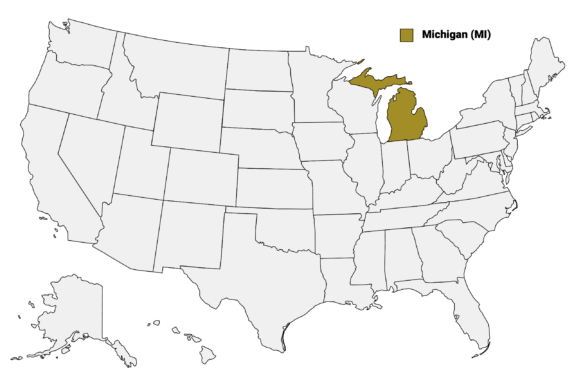
There are 83 counties in Michigan, which are spread out over the state’s Upper and Lower Peninsulas. The counties in the Upper Peninsula are generally larger in size and less populous than their counterparts in the Lower Peninsula.
In this post, we’ll look at a detailed Michigan Counties Map and provide a table that lists important information about each. Then, we’ll go into more detail about some of the state’s most interesting counties, starting with the most populous.
Map of Michigan Counties
Below is a map of the 83 counties of Michigan (you can click on the map to enlarge it and to see the major city in each county).
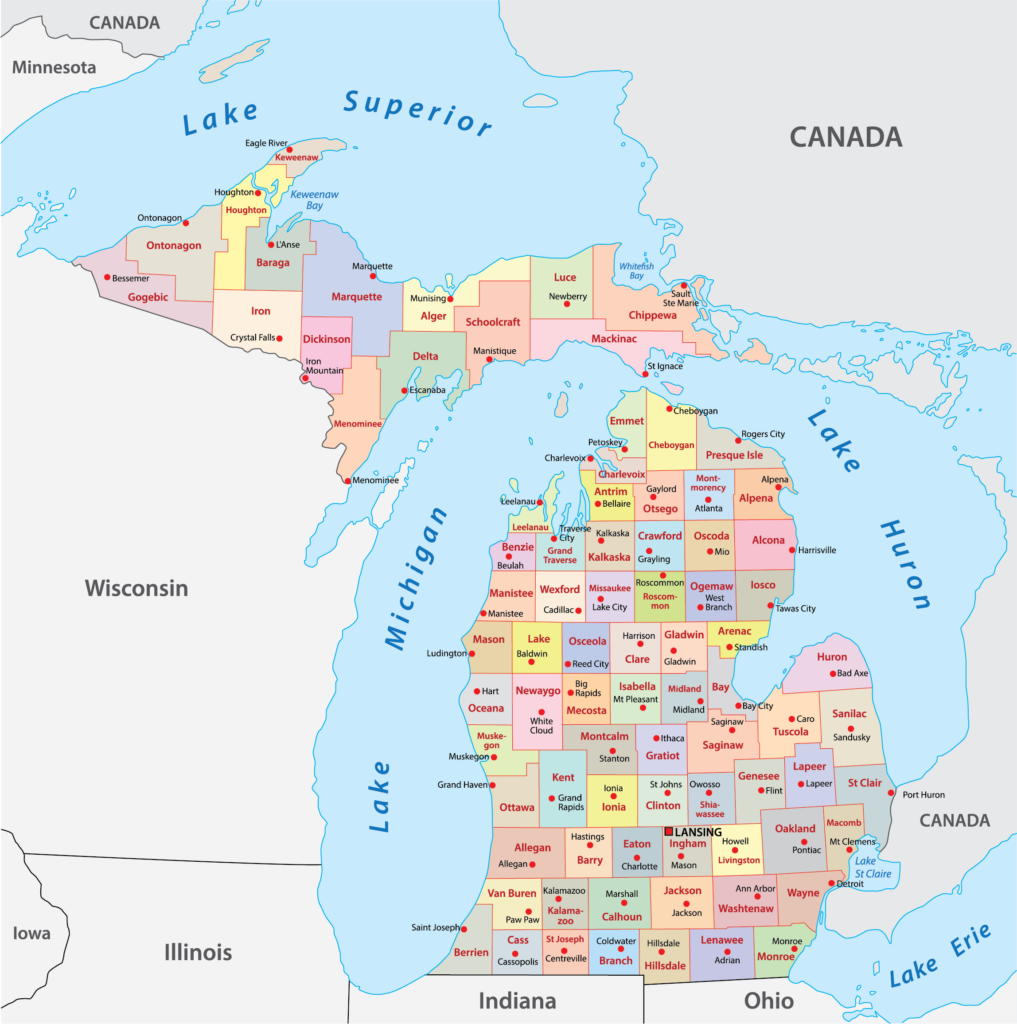
Interactive Map of Michigan Counties
Click on any of the counties on the map to see its population, economic data, time zone, and zip code (the data will appear below the map). Data is sourced from the US Census 2021.
List of the Counties of Michigan:
| County | Population | Per sq. km | Largest City |
|---|---|---|---|
| Alcona County | 10,138 | 5.8 | Hubbard Lake |
| Alger County | 8,911 | 3.76 | Munising |
| Allegan County | 119,418 | 55.87 | Holland |
| Alpena County | 28,913 | 19.52 | Alpena |
| Antrim County | 23,427 | 19.02 | Mancelona |
| Arenac County | 15,009 | 15.96 | Standish |
| Baraga County | 8,249 | 3.55 | L’Anse |
| Barry County | 62,014 | 43.29 | Hastings |
| Bay County | 104,050 | 90.81 | Bay City |
| Benzie County | 17,926 | 21.65 | Frankfort |
| Berrien County | 154,263 | 104.9 | Niles |
| Branch County | 44,677 | 34.06 | Coldwater |
| Calhoun County | 134,207 | 73.37 | Battle Creek |
| Cass County | 51,632 | 40.68 | Niles |
| Charlevoix County | 26,109 | 24.21 | Boyne City |
| Cheboygan County | 25,654 | 13.85 | Cheboygan |
| Chippewa County | 37,091 | 9.19 | Sault Ste. Marie |
| Clare County | 30,827 | 21.09 | Clare |
| Clinton County | 78,895 | 53.79 | Lansing |
| Crawford County | 13,102 | 9.09 | Grayling |
| Delta County | 36,836 | 12.14 | Escanaba |
| Dickinson County | 25,954 | 13.17 | Iron Mountain |
| Eaton County | 108,972 | 73.15 | Lansing |
| Emmet County | 33,946 | 28.03 | Petoskey |
| Genesee County | 406,400 | 246.35 | Flint |
| Gladwin County | 25,344 | 19.5 | Gladwin |
| Gogebic County | 14,858 | 5.21 | Ironwood |
| Grand Traverse County | 94,562 | 78.63 | Traverse City |
| Gratiot County | 41,758 | 28.37 | Alma |
| Hillsdale County | 45,673 | 29.48 | Hillsdale |
| Houghton County | 37,485 | 14.34 | Houghton |
| Huron County | 31,542 | 14.57 | Bad Axe |
| Ingham County | 285,660 | 198.34 | Lansing |
| Ionia County | 66,564 | 44.98 | Ionia |
| Iosco County | 25,262 | 17.76 | East Tawas |
| Iron County | 11,580 | 3.83 | Iron River |
| Isabella County | 65,623 | 44.24 | Mount Pleasant |
| Jackson County | 160,765 | 88.43 | Jackson |
| Kalamazoo County | 261,280 | 179.52 | Kalamazoo |
| Kalkaska County | 17,813 | 12.29 | Kalkaska |
| Kent County | 654,958 | 297.88 | Grand Rapids |
| Keweenaw County | 2,052 | 1.47 | Mohawk |
| Lake County | 12,248 | 8.33 | Baldwin |
| Lapeer County | 88,644 | 52.9 | Lapeer |
| Leelanau County | 22,251 | 24.74 | Traverse City |
| Lenawee County | 99,346 | 51.17 | Adrian |
| Livingston County | 193,234 | 131.98 | Fenton |
| Luce County | 5,520 | 2.37 | Newberry |
| Mackinac County | 10,814 | 4.09 | St. Ignace |
| Macomb County | 879,123 | 708.11 | Warren |
| Manistee County | 24,939 | 17.76 | Manistee |
| Marquette County | 66,380 | 14.17 | Marquette |
| Mason County | 29,103 | 22.7 | Ludington |
| Mecosta County | 40,051 | 27.85 | Big Rapids |
| Menominee County | 23,477 | 8.68 | Menominee |
| Midland County | 83,467 | 62.28 | Midland |
| Missaukee County | 15,038 | 10.28 | Lake City |
| Monroe County | 154,068 | 108.28 | Monroe |
| Montcalm County | 66,430 | 36.36 | Greenville |
| Montmorency County | 9,164 | 6.47 | Lewiston |
| Muskegon County | 175,633 | 134.57 | Muskegon |
| Newaygo County | 49,653 | 22.85 | Fremont |
| Oakland County | 1,271,983 | 566.26 | South Lyon |
| Oceana County | 26,555 | 19.05 | Shelby |
| Ogemaw County | 20,745 | 14.21 | Skidway Lake |
| Ontonagon County | 5,891 | 1.73 | Ontonagon |
| Osceola County | 22,917 | 15.63 | Reed City |
| Oscoda County | 8,206 | 5.6 | Mio |
| Otsego County | 25,016 | 18.75 | Gaylord |
| Ottawa County | 293,713 | 201.24 | Holland |
| Presque Isle County | 12,976 | 7.61 | Rogers City |
| Roscommon County | 23,458 | 17.42 | Houghton Lake |
| Saginaw County | 190,540 | 91.87 | Saginaw |
| Sanilac County | 40,829 | 16.38 | Sandusky |
| Schoolcraft County | 8,004 | 2.64 | Manistique |
| Shiawassee County | 68,203 | 49.6 | Owosso |
| St. Clair County | 160,067 | 85.66 | Port Huron |
| St. Joseph County | 60,828 | 46.91 | Sturgis |
| Tuscola County | 53,288 | 25.56 | Caro |
| Van Buren County | 75,550 | 47.99 | South Haven |
| Washtenaw County | 372,428 | 203.68 | Ann Arbor |
| Wayne County | 1,789,781 | 1129.41 | Detroit |
| Wexford County | 33,552 | 22.93 | Cadillac |
Largest Counties in Michigan by Population
Wayne County
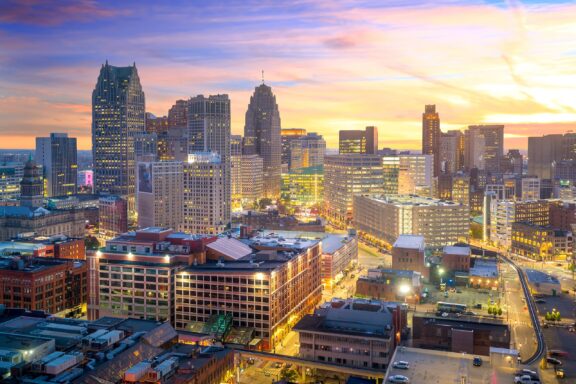
Wayne County, established in 1796, holds the distinction of being the most populous county in Michigan. Its county seat, Detroit, is famously known as “Motor City” for its pivotal role in the American automotive industry.
The county’s name honors General Anthony Wayne, a Revolutionary War hero. Notably, Wayne County is located in southeastern Michigan, bordering Lake Erie. This location contributed to Detroit’s development as a major port city.
Historically, Wayne County has been a melting pot of cultures, reflected in Detroit’s rich musical heritage, notably Motown Records and now the Motown Museum. The county also features significant landmarks like the Detroit Institute of Arts and the historic district of Dearborn, home to The Henry Ford Museum, showcasing America’s innovation journey.
In addition to Wayne County’s urban landscapes, it features scenic riverfronts, with the Detroit River International Wildlife Refuge being a highlight.
Oakland County
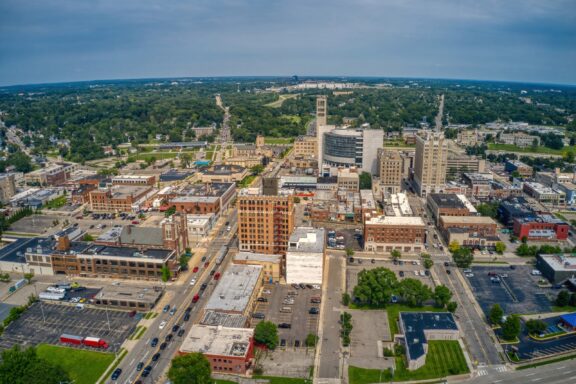
Oakland County, located directly north of Wayne County in southeastern Michigan, is known for its affluent suburbs and thriving economy. Originally established in 1820, it was named for the oak trees that once covered its land. The county seat is Pontiac, historically a hub for the automotive industry, notably hosting General Motors.
Oakland County is characterized by a blend of urban and natural landscapes. It boasts over 1,400 lakes, making it a popular destination for outdoor activities like boating and fishing. The county is also a cultural center, with attractions such as the Cranbrook Art Museum and the Meadow Brook Hall, a Tudor-revival mansion reflecting the opulence of the automotive barons.
Economically, Oakland County has a diverse and robust economy, with a significant presence in the automotive, technology, and healthcare sectors. Its affluence is evident in upscale communities like Bloomfield Hills and Rochester Hills, known for their high-quality living standards and excellent schools.
Macomb County
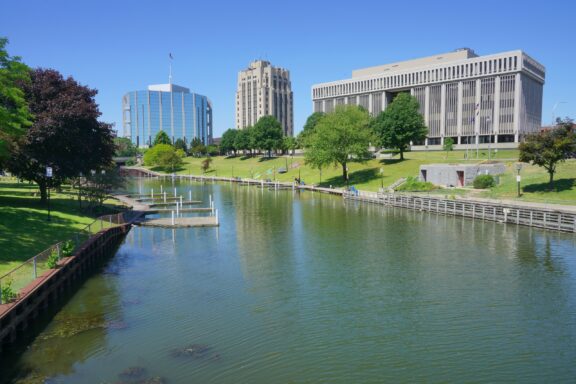
Macomb County, established in 1818, is situated in southeastern Michigan, bordering Lake St. Clair. Named after Alexander Macomb, a War of 1812 hero, it has grown into a populous and economically significant region. The county seat, Mount Clemens, gained fame in the 19th century for its mineral baths, attracting visitors nationwide.
The county’s development was heavily influenced by its location along the Clinton River and Lake St. Clair, fostering a strong maritime tradition. Today, Macomb is home to the Selfridge Air National Guard Base, playing a crucial role in both the local economy and national defense.
The county is also renowned for its outdoor recreational opportunities, including boating and fishing on Lake St. Clair. The Macomb Center for the Performing Arts and the Anton Art Center in Mount Clemens are cultural keystones, showcasing local and national talent.
Kent County
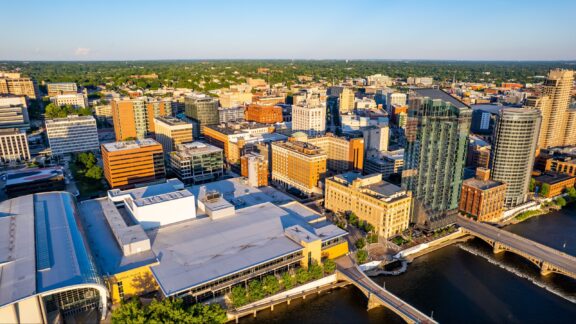
Kent County, established in 1831, is situated in western Michigan. Its name honors James Kent, a jurist who made significant contributions to American law. The county seat, Grand Rapids, is known as “Furniture City” due to its long history in furniture manufacturing.
The county’s position on the Grand River played a crucial role in its development. Grand Rapids’ reputation for furniture production began in the 19th century, and it still hosts major furniture companies today. As a hub for arts and culture, the city hosts the annual ArtPrize competition, which draws international attention.
Kent County is also recognized for its natural beauty, with extensive park systems and trails. These include the Frederik Meijer Gardens & Sculpture Park, combining art and natural landscapes. The county’s economy is diverse, with healthcare, education, and manufacturing being significant sectors.
Genesee County
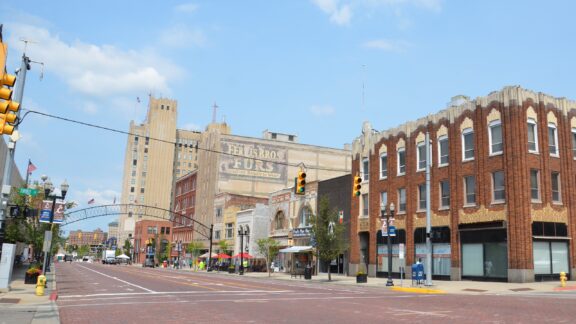
Genesee County, established in 1835, is located in eastern Michigan. The county was named after Genesee County, New York, whose name comes from a Seneca word meaning “the beautiful valley.”
Its county seat, Flint, gained prominence in the early 20th century as a major player in the automotive industry, particularly as the birthplace of General Motors. After the automotive boom, the county faced challenges during the industry’s decline. Flint has since placed a focus on education and health services, with institutions like Kettering University and the Hurley Medical Center.
In addition to its urban areas, Genesee County offers natural attractions like the Flint River Trail and the Stepping Stone Falls. Cultural highlights include the Flint Institute of Arts, one of the largest art museums in Michigan, and The Whiting, a performance venue hosting various arts and cultural events.
Smallest Counties in Michigan by Population
Keweenaw County
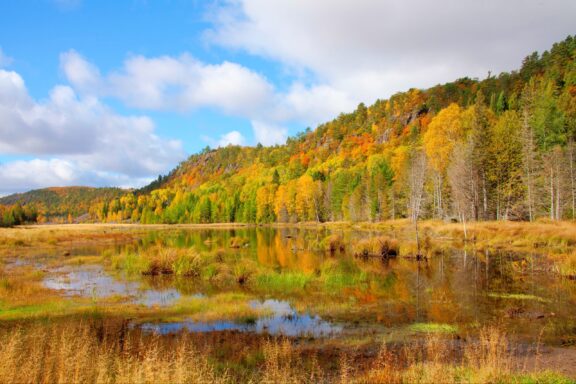
Keweenaw County, established in 1861, holds the distinction of being the least populous county in Michigan. It is located in the Upper Peninsula, on the northern tip of the Keweenaw Peninsula, jutting into Lake Superior. The county was named after the Ojibwe word “Keweenaw,” meaning “portage.”
The county seat is Eagle River, a small town known for its picturesque landscapes and historic charm. Keweenaw County’s history is deeply rooted in copper mining, which was done by indigenous inhabitants of the peninsula thousands of years ago and dramatically shaped the region’s development in the 19th century.
The remnants of this era are still visible in the abandoned mines and ghost towns scattered across the landscape. The county is also part of the Keweenaw National Historical Park, which preserves the region’s copper mining history.
Luce County
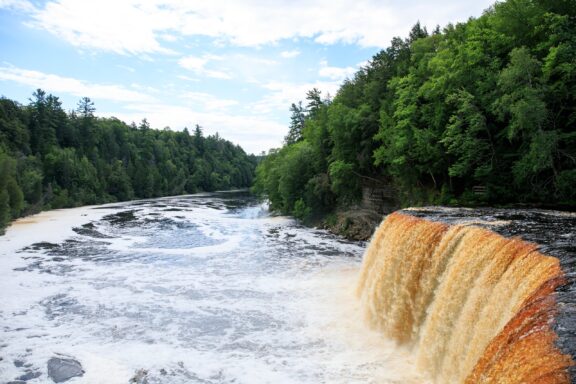
Luce County has the second smallest population of any in the state of Michigan. It’s located in Michigan’s Upper Peninsula and was organized in 1887. The county seat and only incorporated community in Luce County is Newberry, which is known as the “Moose Capital of Michigan.”
Surrounded by state forests and Lake Superior, Newberry is considered the southern gateway to the Tahquamenon Falls State Park. The park is home to campgrounds, a boat launch, and miles of trails with viewpoints of the Upper and Lower Falls.
The county’s economic history is rooted in lumbering, though today the economy is largely driven by tourism, forestry, and outdoor recreation. The county is also a gateway to the Pictured Rocks National Lakeshore and Seney National Wildlife Refuge, drawing nature enthusiasts for activities like hiking, fishing, and birdwatching.
Ontonagon County
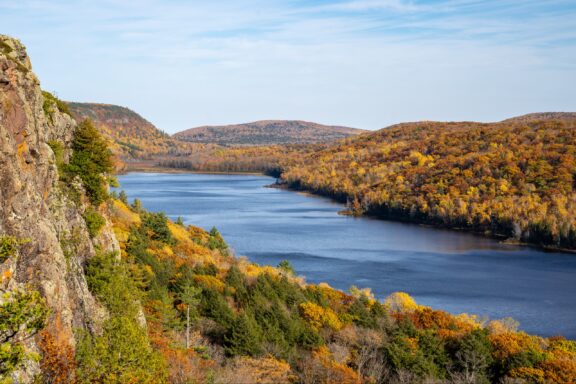
Ontonagon County, established in 1848, is located in the western Upper Peninsula of Michigan, bordering Lake Superior. The county’s name is derived from the Ojibwa language, possibly translating to “hunting river,” a testament to the area’s rich natural resources. The county seat is Ontonagon, situated near the mouth of the Ontonagon River on the shores of Lake Superior.
Historically, Ontonagon County’s economy was heavily influenced by copper mining, and The Adventure Mine and the Old Victoria Restoration are reminders of this era, offering insights into the region’s mining history.
Today, Ontonagon County is a destination for outdoor enthusiasts, featuring the Porcupine Mountains Wilderness State Park, one of the few remaining large wilderness areas in the Midwest. The park is known for its extensive hiking trails, scenic vistas, and the Lake of the Clouds.
Notable Counties in Michigan
Marquette County
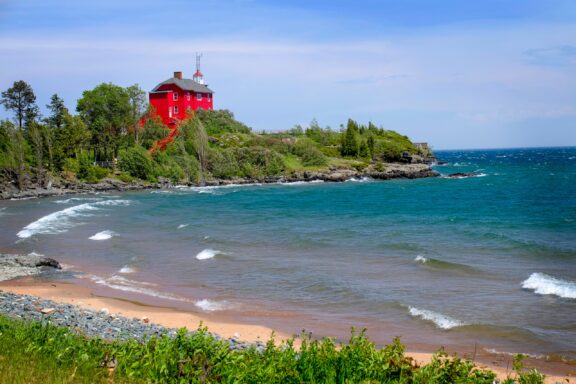
Marquette County is notable for being the largest in Michigan by land area. Situated in the state’s Upper Peninsula, it encompasses diverse landscapes like Lake Superior’s rugged shoreline and dense forests. The county seat, Marquette, is a major port city on Lake Superior, known for its natural beauty and outdoor recreation opportunities, including hiking, skiing, and kayaking.
Established in 1843 and organized in 1851, the county was named after Jacques Marquette, a Jesuit missionary. The county played a significant role in the iron mining industry, which is evident in sites like the Michigan Iron Industry Museum.
Marquette County is also home to Northern Michigan University, contributing significantly to the region’s educational and cultural landscape. The city of Marquette, with its historic downtown, hosts numerous cultural events, including the annual Hiawatha Traditional Music Festival.
Washtenaw County
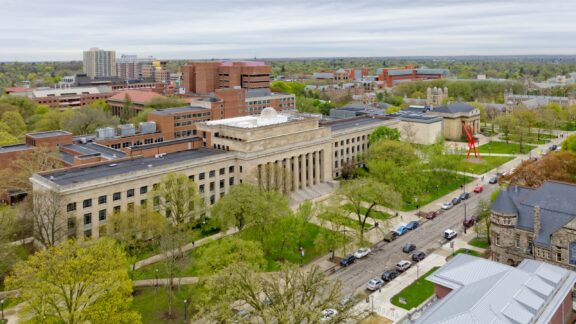
Washtenaw County, located in southeastern Michigan, is renowned for its educational and cultural impact, largely due to the presence of the University of Michigan in Ann Arbor, its county seat.
Formally organized in 1826, the county’s name is believed to be derived from an Ojibwa word, though its exact meaning is debated. Ann Arbor, a pivotal center of political activism and research innovation, hosts a diverse, highly educated community.
The university’s influence extends beyond academia, fostering a thriving arts scene evident in numerous galleries, theaters, and festivals like the Ann Arbor Art Fair. Washtenaw County also encompasses the city of Ypsilanti, home to Eastern Michigan University, further enriching the county’s educational landscape.
Apart from its urban areas, Washtenaw County features picturesque rural and suburban landscapes, including parts of the Huron River and extensive park systems.
Leelanau County
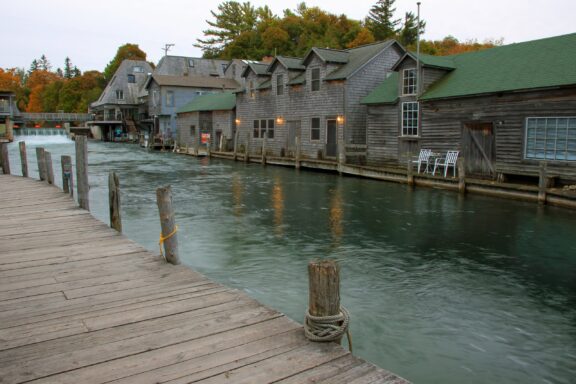
Leelanau County, nestled in northern Lower Michigan on the picturesque Leelanau Peninsula, is celebrated for its breathtaking natural beauty and extensive Lake Michigan shoreline. Established in 1863, the county’s name is said to have come from a term created by writer Henry Rowe Schoolcraft.
The county seat, Leland, is known for its historic Fishtown, where weathered fishing shanties line the waterfront, offering a glimpse into the county’s maritime heritage.
Leelanau County is a haven for nature lovers and outdoor enthusiasts, boasting the renowned Sleeping Bear Dunes National Lakeshore, acclaimed for its stunning dunes, beaches, and hiking trails. The county’s unique microclimate also supports a flourishing wine industry, with numerous vineyards and wineries dotting the landscape.
The region’s small towns, such as Suttons Bay and Northport, offer a blend of art, culture, and history, with galleries, boutiques, and local festivals like the Suttons Bay Art Festival.
Ingham County
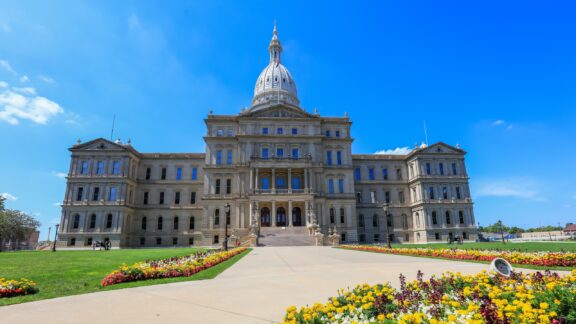
Ingham County, established in 1838 in central Michigan, is notable for being home to Lansing, the state capital, and East Lansing, where Michigan State University is located. The county, named after Samuel D. Ingham, a U.S. Treasury Secretary under President Jackson, plays a significant role in state politics and education.
Lansing, as the state capital, hosts various government buildings and historical landmarks, including the impressive Michigan State Capitol building. The city’s cultural scene is enriched by museums, art galleries, and theaters.
East Lansing contributes to the county’s vibrancy with its collegiate atmosphere surrounding Michigan State University, a major public research institution. The university’s campus is a hub of academic, athletic, and cultural activities, featuring the renowned Wharton Center for Performing Arts and the Eli and Edythe Broad Art Museum.
Ingham County also offers diverse outdoor recreation with parks, trails, and the scenic Lansing River Trail.
More About Counties in Michigan: FAQs
How are county governments structured in Michigan?
Michigan counties operate under a Board of Commissioners, elected by residents. These boards have authority over county budgets, ordinances, and policies. Some counties also have elected executives for more centralized administration.
How have Michigan’s counties evolved in terms of population growth?
Michigan’s counties have seen diverse demographic shifts. Urban counties like Wayne and Oakland have experienced fluctuating growth due to industrial changes, while rural counties have seen more stable or declining populations.
How do Michigan counties contribute to the state’s economy?
Contributions to Michigan’s economy vary by county. In counties like Wayne and Oakland, manufacturing is a major sector; agriculture dominates in rural counties; and tourism is prominent in coastal and scenic areas like those in the Upper Peninsula.
What unique environmental conservation efforts are present in Michigan’s counties?
Many Michigan counties have conservation programs focusing on preserving natural habitats, water quality, and parks. Initiatives include managing invasive species, protecting wetlands, and promoting sustainable land use practices.
Image Sources and Copyright Information
- Downtown Detroit at Twilight: Aerial View of the Cityscape with Illuminated Buildings: © f11photo/Shutterstock
- Aerial View of Downtown Pontiac, Michigan with Clear Skies: © Jacob Boomsma/Shutterstock
- Sunny Day View of the Clinton River with Surrounding Buildings in Mount Clemens, Michigan: © Fsendek/Shutterstock
- Aerial View of Downtown Grand Rapids in Kent County: © Wirestock Creators/Shutterstock
- Downtown Street Scene with Historic Buildings in Flint, Michigan: © Susan Montgomery/Shutterstock
- Autumn Colors Reflecting in a Tranquil Lake at Keweenaw Peninsula, Michigan: © Gary R Ennis Photos/Shutterstock
- Breathtaking View of Tahquamenon Falls Amidst Lush Greenery: © UbjsP/Shutterstock
- Autumnal Scenery of a Serene Lake Surrounded by Forested Hills Under a Clear Blue Sky: © melissamn/Shutterstock
- Bright Red Lighthouse on Rocky Shoreline Overlooking a Serene Lake: © Sherry Graham/Shutterstock
- Aerial View of a University Campus with Classic and Modern Buildings Amidst Greenery: © Agnieszka Gaul/Shutterstock
- Quaint Wooden Buildings Along the Waterfront in a Small Fishing Town: © Todd Maertz/Shutterstock
- Michigan State Capitol Building Surrounded by Colorful Flowers on a Sunny Day: © SNEHIT PHOTO/Shutterstock